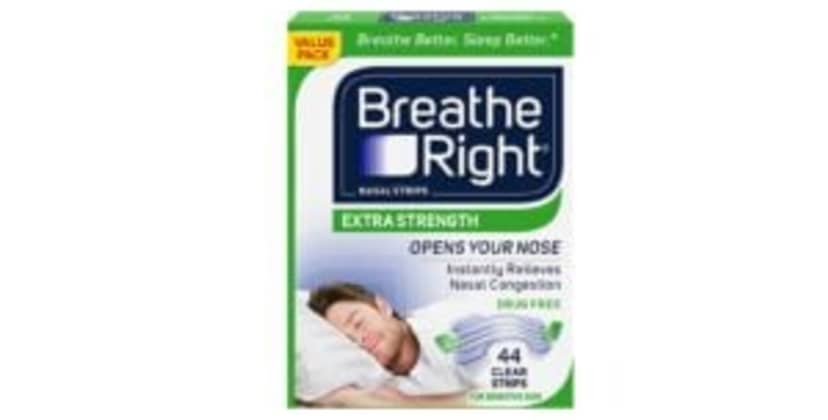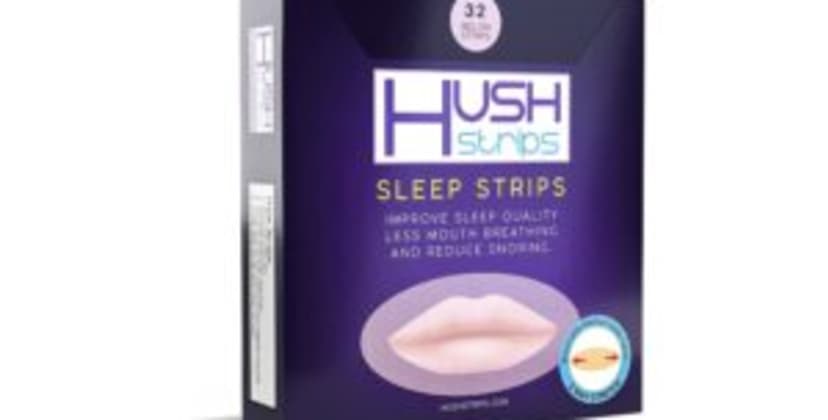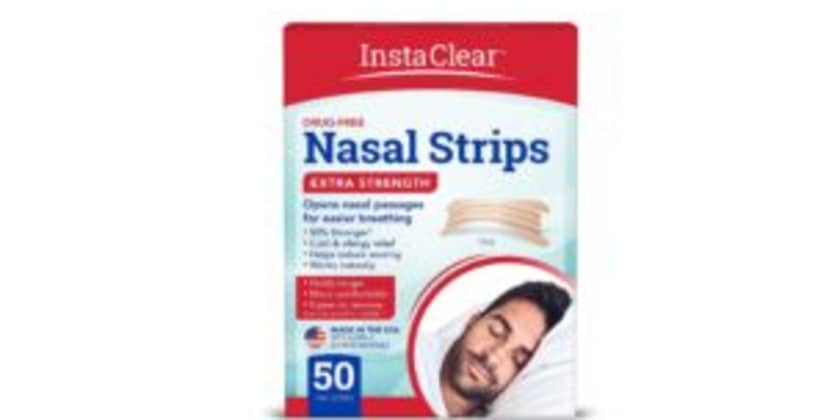When you buy through our links, we may earn a commission. Products or services may be offered by an affiliated entity. Learn more.
Best Nasal Strips for Snoring
Nasal strips are drug-free external nasal dilators that may reduce snoring. They are worn on the nose and use flexible bands with adhesive to widen the nostrils. By improving airflow through the nose, nasal strips may also alleviate stuffiness from allergies and congestion that can contribute to snoring.
Snoring is common among adults, affecting about 57% of men and 40% of women. The distinctive, gravelly sound of snoring is caused by vibrating soft tissues in the back of the throat. Among the many treatments available for snoring, some people find relief using inexpensive and noninvasive approaches like nasal strips.
A nasal strip is a flexible band with a strong adhesive underside. It attaches to the bridge of the nose and gently widens the nostrils. This action is designed to improve airflow through the nose, helping to reduce snoring and nasal congestion. Since they are drug-free, nasal strips are generally considered safe to use with inhalers and other medications.
In-Depth Reviews
Best Overall
Breathe Right Extra Strength Clear Nasal Strips
Use this SleepFoundation.org link for the most current discount on Breathe Right products
Shop Now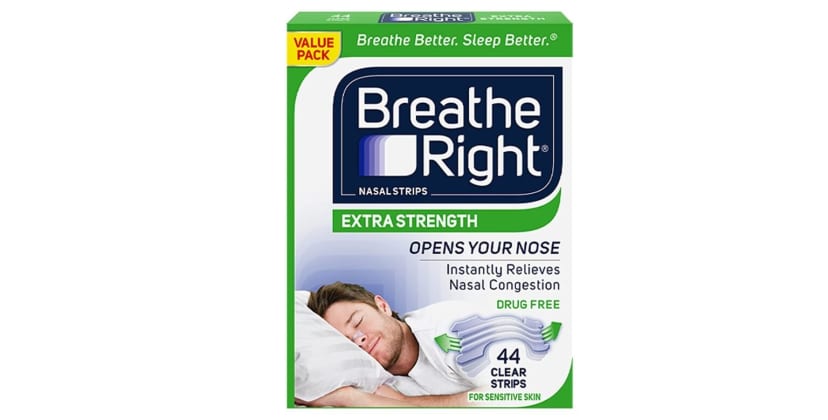
Breathe Right’s Extra Strength Clear Nasal Strips have an inconspicuous design suitable for use during both day and night. These are currently Breathe Right’s strongest nasal strip and are intended to reduce snoring and allergy-related nasal congestion.
-
Who it’s best for
-
People with sensitive skin
-
Snorers with deviated septums
-
Those whose snoring is related to allergies or nasal congestion
-
-
Highlights
-
Clear material
-
Designed to stay in place while sleeping or exercising
-
One-size-fits-all
-
Breathe Right has been selling adhesive nose strips since 1993. The Extra Strength Clear Nasal Strips are the brand’s strongest external nasal dilator available, featuring a three-band design that effectively lifts the nostrils to improve airflow. Strong 3M adhesive keeps the strip in place when sleeping or exercising. The nearly transparent material makes the strips less conspicuous when worn during the day.
The nasal strips adhere best to clean, dry skin. To apply, gently press the strip across the bridge of your nose with the tabs resting just above the nostrils. Breathe Right recommends removing the nasal strip when washing your face or showering by lifting both tabs simultaneously. For those with latex allergies, note that the package seal contains natural latex.
While intended to reduce snoring, the strips can also be used to provide relief from nasal congestion. Breathe Right Extra Strength Clear Nasal Strips come in one standard size designed for adults. They are widely available at drugstores and online retailers like Amazon. Each package contains 44 strips.
Best for Reducing Mouth Breathing
Sunset Hush Strips
Use this SleepFoundation.org link for the most current discount on Sunset products
Shop Now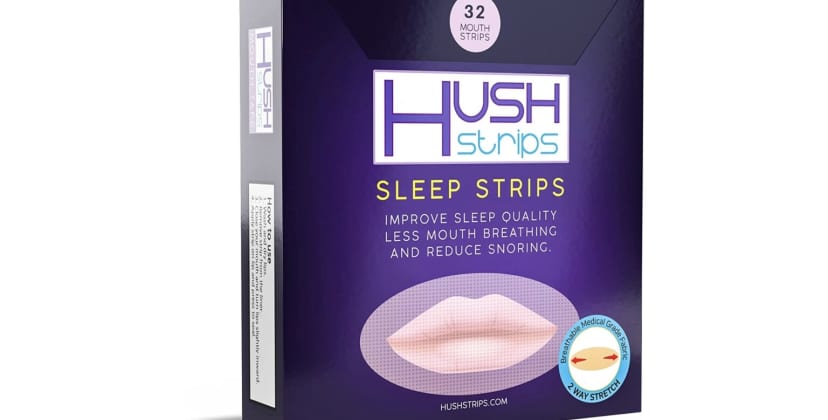
If you snore frequently and mostly breathe through your mouth, Hush Strips may provide the relief you need. Each strip uses flexible fabric and a gentle adhesive to press your lips together, restricting airflow that can lead to snoring for mouth-breathers.
-
Who it’s best for
-
People who primarily breathe through their mouths
-
Anyone who uses a nasal or nasal pillow CPAP mask
-
Value seekers
-
-
Highlights
-
Effective anti-snoring strips made from medical-grade, two-way-stretch fabric
-
Gentle adhesive holds the lips in place without too much force
-
One pack can last a month or longer
-
Price
$18
Nasal strips are effective for many people, but those who primarily breathe through their mouths may need a different course of action to curb their snoring. The aptly named Hush Strips from Sunset are designed to hold your lips together while you sleep, which reduces potential for snoring if you’re a mouth-breather. The adhesive is light yet effective, so the bond should hold steady throughout the night but there shouldn’t be any pain or discomfort when you remove the strip in the morning.
The strips are made from a breathable, non-woven fabric with two-way stretch for added flexibility. This material is both hypoallergenic and medical-grade. Mouth-breathers who use nasal or nasal pillow CPAP masks often find their therapy is ineffective at reducing their snoring. With Hush Strips, this can mean the best of both worlds — a lighter, more comfortable mask and less snoring night after night.
However, Sunset does not recommend the strips for certain people. These include sleepers prone to nasal breathing difficulties, anyone with a body mass index of 35 or higher, and people with sleep apnea who do not use a CPAP machine. You should also avoid the strips after consuming alcohol or sedatives, or if you’ve recently experienced a cold, sinus or ear infection. Additional restrictions may apply, so please consult your doctor before using the strips if you have high blood pressure or heart or breathing problems.
Each strip is designed for single use, and your shipment includes 32 individual strips. Shoppers in the contiguous U.S. qualify for reasonable flat-rate shipping with their Hush Strips order. You may return the strips unopened and unused within 60 days of the delivery date and receive a full refund.
Best Subscription Option
Instaclear Extra-Strength Nasal Strips
Use this SleepFoundation.org link for the most current discount on Instaclear products
Shop Now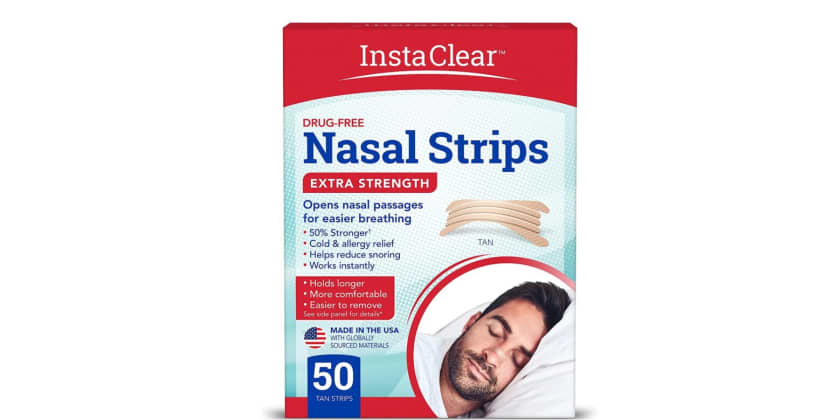
The InstaClear Extra-Strength Nasal Strips strongly adhere to the skin while still being lightweight and flexible. A discounted auto-delivery subscription option is available when purchasing the strips through Amazon.
-
Who it’s best for
-
People who want to improve nasal airflow while exercising
-
Individuals who use nasal strips nightly
-
Those who like the convenience of subscription plans
-
-
Highlights
-
Minimalist tan-colored design
-
Includes 50 strips
-
Discounted subscription option
-
InstaClear’s Extra-Strength Nasal Strips can be used during the day or night to open nasal passages. The banded design easily takes to the skin thanks to extra-strong adhesive. They are latex-free and generally suitable for people with sensitive skin.
Each box includes 50 tan nasal strips. Once on, the strips immediately widen the nasal passage. Because they are drug-free, they shouldn’t interfere with nasal decongestants or medications, but check with your doctor first. The nasal strips may also be used during exercise to improve breathing efficiency.
The strip should be applied to the center of the nose, pressing down for at least 30 seconds. Slowly remove the strip with one hand on each tab. The manufacturer recommends removing the strip when washing your face or showering.
InstaClear Extra-Strength Nasal Strips are available through various retailers, including Amazon, Walmart, and certain drugstores. Shoppers can save up to 15% on the nasal strips with Amazon’s auto-delivery subscription option.
Why You Should Trust Us
As sleep specialists, we’re committed to improving sleep hygiene for readers. Snoring can be a frustrating experience, so we’re continually looking for effective treatment options. Our recommendations for sleep aids are based on careful research and product surveys. We compare different brands and styles to help readers find the most appropriate fit for their needs.
What to Look For in a Nasal Strip
A wide variety of nasal strips are available for consumers, but understanding their main characteristics can help you choose the model that is right for you.
Type
Nasal strips generally include two main design elements. The band is a flexible and tensile component that fits around the bridge of the nose. The adhesive strip is on the underside of the nasal strip and adheres to the skin somewhat like a bandage.
Size
Nasal strip companies often sell their products in small, medium, and large sizes, or hybrids like small/medium or medium/large to help fit a variety of sleepers’ nose sizes.
Strength
Some nasal strip brands are sold in both original and extra-strength versions. Extra-strength strips are typically made from a thicker material so they are less likely to tear during the night or when being applied.
Quantity
Packages are sold in various quantities to meet the frequency-of-use needs of different sleepers. Some packages include as few as 10 strips for an occasional user, while packages with quantities like 72 or 100 strips are available for nightly users.
Aesthetics
Nasal strips may offer other aesthetic features, such as clear models that are less visible on the face, or strips that are scented with an essential oil to have a pleasing aroma.
What Are Nasal Strips?
Nasal strips are an over-the-counter health product that research has found can help reduce snoring. Somewhat similar in appearance to an adhesive bandage with a butterfly shape, they are affixed to the nose at bedtime to help hold sinus tissues in a more optimal position.
Nasal strips, along with other sleep and behavioral adjustments, can be part of an overall plan to reduce mild to moderate snoring. However, people experiencing chronic or severe snoring, or those who experience frequent daytime sleepiness in addition to snoring, should consult with their doctor.
How They Work
Nasal strips adhere to the nose somewhat like a bandage, but they have elastic bands within them that lift the sides of the nose to help pull the nostrils open. For some sleepers, the use of a nasal strip may significantly reduce the occurrence of snoring.
If you have tried self-care for snoring and it has not helped, it is best to speak with a doctor, as your snoring could be related to a more serious condition that warrants additional treatment, such as obstructive sleep apnea (OSA).
Who Should Not Use Nasal Strips
Those who are allergic to latex will need to find a brand that is latex-free. Sleepers with sensitive skin may want to try using a nasal strip that is designed to minimize skin irritation.
People with chronic or severe snoring conditions or those diagnosed with sleep apnea should not use nasal strips as a substitute for seeking medical advice and following the directions provided by a clinician.
What Causes Snoring?
Snoring occurs during sleep when air moving through the nose and throat creates vibrations in the throat’s soft tissues. Potential causes of snoring include being overweight and having nasal congestion due to allergies or illness.
Back sleepers are more likely to snore due to the force of gravity on the upper airway. Consumption of alcohol before bed is also known to increase the chances of snoring. People who are in the final stage of pregnancy have an increased likelihood of snoring.
Other Ways to Reduce Snoring
In addition to using a nasal strip, there are several adjustments you can make as part of an overall self-care plan to reduce snoring frequency. If snoring is an ongoing problem in spite of these adjustments, further consultation with a doctor is advised.
- Sleep on your side: Snoring is more likely for back sleepers due to the orientation of the head and the force of gravity pulling on the soft tissue inside the nose and throat. Shifting to a side sleeping position may reduce the incidence of snoring.
- Elevate your head: Elevating your head, such as with a pillow for snoring or an adjustable bed base, may help reduce snoring frequency and duration. One study found that this technique alone reduced snoring duration by 7%.
- Try a mouthpiece: Anti-snoring mouthpieces are devices designed to open the airway by either holding the tongue in place or moving the lower jaw forward. Like nasal strips, they are generally sold over the counter, but it’s important to consult with your medical provider to see if they are a good option for you.
- Reduce body weight: The likelihood of snoring increases in people who are overweight or obese. Reducing your body weight, in consultation with your physician, can significantly reduce the frequency and duration of snoring.
- Avoid alcohol before bed: Alcohol consumption before bed increases the chances of snoring. Avoid alcohol around bedtime to help reduce symptoms.
- Quit smoking: Smoking is associated with snoring, with elevated use of smoking tobacco products correlating with increased frequency of snoring. In addition to having other health benefits, quitting smoking may reduce snoring.
Frequently Asked Questions
Do nasal strips work for snoring?
Nasal strips can be one tool in an arsenal of options that help reduce snoring. Snoring has a variety of causes and risk factors, so the optimal solution for each sleeper can vary and may require a combination of sleep aids and lifestyle adjustments. Some sleepers will find their chronic or severe snoring requires additional medical consultation.
What is the difference between snoring and sleep apnea?
Snoring is a vibration in the soft tissues of the back of the throat as we breathe in and out during sleep. Although it is quite common, it can be discomforting or annoy a sleep partner. Sleep apnea is a condition in which breathing pauses during sleep. Because sleep apnea can reduce a person’s oxygen intake, it warrants additional medical attention.
Are nasal strips safe to use every night?
Nasal strips are safe to use every night, but research into their safety generally assumes they are worn for about 8 hours and no more than 12 hours per day. A potential side effect is skin irritation at the application site.
Where can I buy nasal strips for snoring?
Nasal strips are a widely available over-the-counter health aid, so they can be found in most drugstores and on the websites of major national drugstore chains and other third-party retailers and online marketplaces. They can also be found in the health and beauty departments of larger supermarkets and big-box stores.

Still have questions?
Our product experts have extensive experience testing just about every sleep product on the market.
Send an email to [email protected] with your questions and we’ll help you find exactly what you’re looking for.

